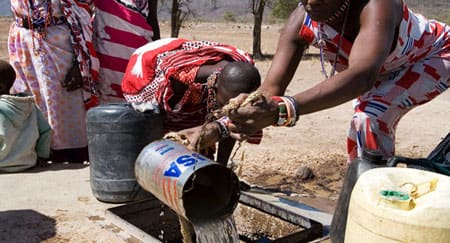Predictions that the next major war will be over water are common. But is this realistic? Bezen Balamir Coskun looks at the type and level of conflicts water shortages are likely to cause.

A source of wellbeing: An artificial well built by the Practical Action charity in Kenya
(© Science Photo Library / Van Parys Media )
Nowadays, the term ‘security’ is interpreted in many different ways. Its meanings range from a strict definition of safety from armed conflict, to a more general interpretation of ‘human security’, which includes social, environmental and broader aspects.
Concepts of food security, energy security and access to natural resources have been widely discussed over the past few decades. But recently the relationship between the environment and security is increasingly acknowledged.
In particular, water resources is an issue that reflects a link between environmental degradation and the outbreak of conflicts. As a security threat, fresh water scarcity is not just a direct cause of insecurity; it is also an indirect security threat, through its potential for causing conflicts.
Eau de vie
Fresh water is a fundamental resource, essential for agriculture, running industries, providing energy, and ensuring health and sanitation.
However, water resources are very unevenly distributed. Some parts of the earth have an abundance of freshwater resources. But according to the UN Commission for Sustainable Development, more than 40 per cent of countries lie within water stress zones. This means the water used annually exceeds 20 per cent of the total domestic renewable fresh water supply.
A substantial portion of fresh water in basins is shared by two or more nations. Water scarcity can therefore lead to either low density conflicts - or the full waging of a war.
Water-related tensions between countries often stem from reasons such as high population density, low per capita income, unfriendly relations, minority groups who internationalize the issue of water scarcity, implementation of large water development projects, and limitations of fresh water treaties.
Today’s major security threat relating to water scarcity is not water wars…it is the human security aspect of water scarcity likely to cause national and international security threats
A key spark for water-related tensions is a mismatch between the population and its necessary levels of freshwater. This can produce water conflict at a local level, such as between tribes over grazing rights or the property right over wells as has happened in Ethiopia.
Or tensions can come due to construction of a dam or canal which impacts water availability for riparian states, such as experienced during 1990s by Turkey, Syria and Iraq over the Turkey’s Greater Anatolia Project on the Euphrates – Tigris river Basin.
Equally, when a country suddenly dissolves, this can transform a national river basin into one shared by several sovereign states, as experienced in the former Yugoslavia and Soviet Union.
Conflict, tension…but not war
In spite of the gloomy predictions about the coming wars involving water sharing in water-poor regions, no major ‘water wars’ have yet occurred. Although 28 per cent of tensions over water were conflictive, no events were found at the extremes of the intensity scale – no formal declaration of war over water and no countries voluntarily unifying into one nation over water, according to research by the University of Oregon.
Today’s major security threat relating to water scarcity is not water wars. Rather, it is the human security aspect of water scarcity which seems likely to cause security threats both nationally and internationally.
First, insufficient food production due to water shortages, in combination with the population growth common in most Third World countries, leads to deteriorating living conditions in water stress zones. It also triggers environmental problems like the depletion of water supplies, deforestation and desertification. One of the consequences is poverty, malnutrition and occasional famines – and this may produce migration flows either domestically or into neighbouring countries. ‘Poverty refugees’ often end up in equally poor countries, as experienced in the Horn of Africa.
Not only can water shortages produce the seeds of conflict, but conflict can also cause water shortages. People fleeing armed conflict bring heavier water demand. For example, in 2006 the number of Eritrean refugees seeking asylum in Sudan increased by 30 per cent. This sudden increase has caused further pressure on limited water resources in Sudan. This trend is set to grow with increased climate change.
Leaking support to radicals
Second, societies and groups whose access to water is restricted by authorities may become increasingly marginalized. This can lead these societies and groups to be attracted by radicalism.
The rise of Hezbollah in Lebanon also illustrates the link between water scarcity and increased support for radical groups. One of the main sources of turmoil in Lebanon is the low standard of living and government negligence of economic development in parts of southern Lebanon, where the mainly Shiite population lives. These Shia Muslims, once a marginalized sect, have organized and galvanized themselves politically around Hezbollah (“Party of God”). In 1997, a peaceful ‘revolt of the hungry’ deteriorated into a violent confrontation followed by the Hezbollah leader’s demands for greater attention to economic development, including irrigation projects in the long-neglected southern region.
Not only can water shortages produce the seeds of conflict, but conflict can also cause water shortages
Third, an ongoing conflict may also create, or at least exacerbate, water problems. Conflicts have direct effects on water resources such as the pollution of water. For example, during the Rwandan genocide, corpses in wells, rivers and streams polluted water resources, then carried risks of transmitting infectious diseases. The Danube River was also polluted during the conflicts in the former Yugoslavia, both in Bosnia and even more so in the war over Kosovo.
In other instances, dams and dykes have been hit in air campaigns, including multi-purpose dams, pumping stations and sewage facilities during, for example, the first Gulf War.
The resulting loss of electrical production facilities had a cascading effect on water supply, sanitation and refrigeration. This severely disrupted systems pumping saline water from irrigated lands in the southern floodplain, leading to widespread waterlogging and salination.
What to do?
To head off water’s potential for conflict and radicalism, disadvantaged groups need to be assured that they have access to the resources they need to live. Both states and international organisations have a role to play. Enhanced security demands increasingly that water resources be obtained cooperatively, rather than competitively.

